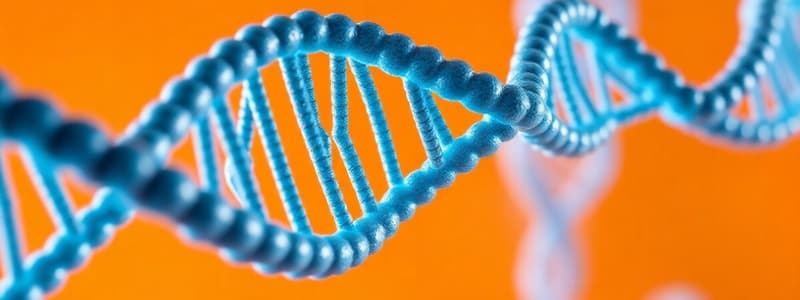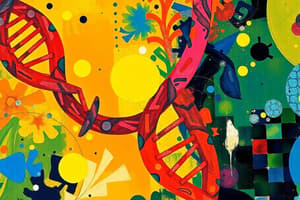Podcast
Questions and Answers
What model of DNA replication ensures that each newly synthesized strand remains paired with its original template strand?
What model of DNA replication ensures that each newly synthesized strand remains paired with its original template strand?
- Conservative replication
- Semi-conservative replication (correct)
- Dispersive replication
- Non-conservative replication
Which enzyme is responsible for relieving supercoiling during DNA replication?
Which enzyme is responsible for relieving supercoiling during DNA replication?
- Primase
- Helicase
- Single-stranded binding proteins
- Topoisomerase (correct)
What happens during the Meselson and Stahl experiment that ruled out conservative replication?
What happens during the Meselson and Stahl experiment that ruled out conservative replication?
- Intermediate density was observed after one replication cycle (correct)
- Two distinct bands were observed after one cycle
- Multiple bands developed after two cycles
- Complete separation of parental strands occurred
How does the origin of replication differ between bacteria and eukaryotes?
How does the origin of replication differ between bacteria and eukaryotes?
Which of the following roles does primase play in DNA replication?
Which of the following roles does primase play in DNA replication?
Which protein stabilizes single-stranded DNA after being unwound during replication to prevent reformation of secondary structures?
Which protein stabilizes single-stranded DNA after being unwound during replication to prevent reformation of secondary structures?
What is the primary role of RNAse H in DNA replication?
What is the primary role of RNAse H in DNA replication?
What significant outcome is produced by the dispersive model of DNA replication after two cycles?
What significant outcome is produced by the dispersive model of DNA replication after two cycles?
Flashcards
Semi-conservative replication
Semi-conservative replication
The method of DNA replication where the newly synthesized DNA strands consist of one parental strand and one newly synthesized strand. This ensures that each daughter DNA molecule contains one original strand from the parent molecule.
Helicase
Helicase
An enzyme that catalyzes the unwinding of the DNA double helix, separating the two strands to allow replication.
Single-stranded binding proteins (SSBPs)
Single-stranded binding proteins (SSBPs)
Proteins that bind to single-stranded DNA, preventing it from folding back on itself and forming secondary structures. This is critical during DNA replication.
Origin of replication
Origin of replication
Signup and view all the flashcards
Replication fork
Replication fork
Signup and view all the flashcards
Topoisomerase
Topoisomerase
Signup and view all the flashcards
Primer
Primer
Signup and view all the flashcards
Okazaki fragments
Okazaki fragments
Signup and view all the flashcards
Study Notes
DNA Replication Overview
- RNA has roles as an information carrier (mRNA) and catalyst (ribosomes).
- DNA replication models include conservative (parental strands always together), semi-conservative (one template strand and one new strand), and dispersive (alternating parent and daughter DNA).
- Meselson and Stahl's experiment proved semi-conservative replication. Conservative and dispersive models were disproven.
Meselson-Stahl Experiment Details
- Experiment ruled out conservative replication due to intermediate density after one cycle.
- Dispersive model was also ruled out after two replication cycles, as intermediate density should have progressively decreased but did not.
Replication Fork and Origins
- Replication fork: Where DNA strands separate during replication.
- Origin of replication: DNA sequence where replication begins on chromosomes/plasmids. This is where DNA unwinds.
Bacterial vs. Eukaryotic Replication
- Bacteria: Uni-directional replication with one origin.
- Eukaryotes: Bi-directional replication with multiple origins.
Enzymes in DNA Replication
- Helicase:
- Binds to single-stranded DNA (ssDNA) and hydrolyzes ATP to move along the strand.
- Unwinds DNA by displacing the other strand when it encounters double-stranded regions.
- Assembled as a homohexamer with a pore for ssDNA passage.
- Single-stranded binding proteins (SSBs):
- Straightens DNA to prevent folding, slowing DNA polymerase.
- Presents bases upwards for incoming dNTPs to dock.
- Topoisomerase:
- Relieves DNA supercoiling, allowing replication to proceed.
- Two classes:
- Topoisomerase I: Creates single-strand breaks.
- Topoisomerase II: Creates double-strand breaks, resealing after unwinding DNA.
- Primase:
- Initiates replication by joining two NTPs to provide the 3'OH that DNA polymerase requires to extend.
- RNA primer: Approximately 10 nucleotides long.
- RNAse H:
- Digests most of the RNA primer, but cannot break RNA-DNA bonds.
- DNA polymerase I:
- Digests the final RNA primer, catalyzing DNA synthesis across the gap.
- DNA ligase:
- Joins Okazaki fragments.
- Catalyzes the formation of a covalent bond by attacking a phosphate AMP bond on one strand with the 3'OH on the other strand. This releases AMP.
Studying That Suits You
Use AI to generate personalized quizzes and flashcards to suit your learning preferences.
Description
Explore the fundamentals of DNA replication, including various models and the significant Meselson-Stahl experiment that confirmed semi-conservative replication. Understand the roles of RNA and the differences between bacterial and eukaryotic replication processes. This quiz will help reinforce essential concepts in molecular biology.




